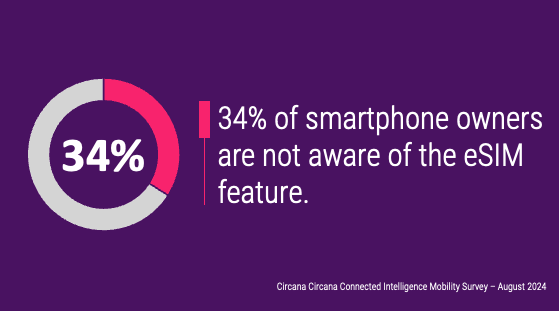
AT&T offers service test drives
Using eSIM functionality, smartphone users on other carriers can now try AT&T’s service to test its reception and reliability in their areas. Similar trial functions have also been offered by competitors. Bringing their own device and phone number, the trial service will work for 30 days, during which prospective customers can use unlimited talk and text, 100 GB of cellular data as well as 25 GB of hotspot data. Current restrictions on this promotion are that the user’s phone must be unlocked, and be an iPhone. Android users will be able to experience the trial as well, beginning in 2025.
The Circana Take:
- AT&T’s trial currently being available only to unlocked iPhone users has a couple of challenges. Depending on the carrier, many smartphones remain locked through the duration of the customer’s installment payment plan for the device itself, and therefore cannot participate in the trial service. Additionally, our Circana Connected Intelligence surveys reveal that Android owners are more likely to be aware of unlocked phones, and to use an unlocked phone, than iPhone users. If the FCC proposal to make all phones unlocked passes, this will become a less critical component.
- A positive side effect of trials like these can be increased awareness of “bring your own device” (BYOD) models that carriers promote. Customers also may not realize the benefits of an unlocked phone, like the ease at which they can switch carriers. BYOD offers benefit smartphone owners who want to keep their number and do not yet want to upgrade their phone, as well as carriers that do not need to subsidize a new device.
- Through increasing awareness of the eSIM capabilities that make this trial service possible, customers can gain an understanding of the freedoms they have with their phones. This has implications for general smartphone unlocking, as well as for special occasions such as travel. Knowing that one does not need a physical SIM card to access a new cellular provider, international travelers can seek temporary eSIM services to connect them during their stays in other countries, rather than being tied to their current provider’s travel plan, which can be more costly.
Verizon updates family features
Verizon has revamped its family safety offerings. The Verizon Family app now allows parents and children to stay in touch and monitor activity with GPS tracking, location arrival and departure alerts, Safe Walk SOS alerts and safety features, Call & Text monitoring to review contact activity and set trusted contacts, and Driving Insights. The app is compatible regardless of the operating systems of the family members’ smartphones. There is a free version of the app with basic features, and a paid version that is available for $14.99 per account, which allows for more direct actions and controls.
The Circana Take:
- Our August 2024 Circana Connected Intelligence Mobility survey reveals that it is currently most common for parents to have provided their child with their first smartphone when the child was 10-12 years old. Parents must decide if the pros of their child staying connected outweigh the risks of smartphone ownership. Enhanced parental control features in addition to safety and location updates can provide parents additional comfort, which may speed up their willingness to provide a smartphone to their child at an earlier age. Additionally, our data shows that the largest proportion of parents feel that children only no longer need parental controls on their smartphone once they are 18 years or older, making this essential for all families.
- The cross-operating system functionalities that this app enables are also significant. According to our survey, 65% of iPhone-owning parents have children whose first smartphone was an iPhone. Empowering parents with these safety features when setting up the child’s first device, which does not need match the operating system of their own, offers more options when it comes to entry-level and affordable brands to provide to their young ones. Affordability may also contribute to children receiving their first smartphone at an earlier age.